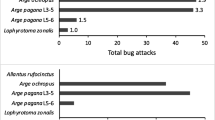Abstract
Coatis (Nasua spp.), gregarious, omnivorous carnivores that range in forests from the southwestern USA to south America, dispatch millipedes by rolling them on the ground using rapid, alternating movements of their forepaws. Prey rolling of millipedes is thought to stimulate the depletion of their defensive secretions and to wipe off secretions before millipedes are consumed. We report that prey-rolling behavior in Nasua spp. is elicited by 1,4-benzoquinone; 2-methyl-1,4-benzoquinone; and 2-methoxy-3-methyl-1,4-benzoquinone, the chief components of the defensive secretions of julidan, spirobolidan, and spirostreptidan millipedes. Chemicals elaborated for defense sometimes evolutionarily “backfire,” providing cues to predators on the presence or identity of prey. The elicitation of prey-rolling behavior in Nasua spp. by benzoquinones illustrates this effect for millipedes (and possibly other arthropods) that defensively discharge these compounds.

Similar content being viewed by others
References
Alves-Costa CP, da Fonseca GAB, Christofaro C (2004) Variation in the diet of the brown-nosed coati (Nasua nasua) in southeastern Brazil. J Mammal 85:478–482
Blum MS (1974) Deciphering the communicative Rosetta Stone. Bull Entomol Soc Am 20:30–35
Blum MS (1981) Chemical defenses of arthropods. Academic, New York
Carroll JF, Kramer M, Weldon PJ, Robbins RJ (2005) Anointing chemicals and ectoparasites: effects of benzoquinones from millipedes on the lone star tick, Amblyomma americanum. J Chem Ecol 31:63–75
Doolan SP, Macdonald DW (1996) Diet and foraging behaviour of group-living meerkats, Suricata suricatta, in the southern Kalahari. J Zool Lond 239:697–716
Eisner T, Alsop D, Hicks K, Meinwald J (1978) Defensive secretions of millipeds. In: Bertini S (ed) Handbook of experimental pharmacology, vol 48. Springer, Berlin, Heidelberg, New York, pp 41–72
Ingles LG (1957) Observations on behavior of the coatimundi. J Mammal 38:263–264
Kaufmann JH (1962) Ecology and social behavior of the coati, Nasua narica, on Barro Colorado Island, Panama. Univ Calif Publ Zool 60:95–222
Raske AG (1967) Morphological and behavioral mimicry among beetles of the genus Moneilema. Pan-Pac Entomol 43:239–244
Rood JP (1975) Population dynamics and food habits of the banded mongoose. East Afr Wildl J 13:89–111
Russell JK (1982) Timing of reproduction by coatis (Nasua narica) in relation to fluctuations in food resources. In: Leigh ES Jr, Rand AS, Windsor DM (eds) The ecology of a tropical forest. Smithsonian Institution Press, Washington, DC, pp 413–431
Santori R (1998) Discrimination of millipedes by the opossum Didelphis albiventris (Marsupialia, Didelphidae). J Adv Zool 19:118–119
Slobodchikoff CN (1978) Experimental studies of tenebrionid beetle predation by skunks. Behaviour 66:313–322
Valderrama X, Robinson JG, Attygalle AB, Eisner T (2000) Seasonal anointment with millipedes in a wild primate: a chemical defense against insects? J Chem Ecol 26:2781–2790
Weldon PJ, Aldrich JR, Klun JA, Oliver JE, Debboun M (2003) Benzoquinones from millipedes deter mosquitoes and elicit self-anointing in capuchin monkeys (Cebus spp.). Naturwissenschaften 90:301–304
Zito M, Evans S, Weldon PJ (2003) Owl monkeys (Aotus spp.) self-anoint with plants and millipedes. Folia Primatol 74:159–161
Acknowledgements
B. Harrod, W. Piechocki, J. Roth, and J. Zolonowski (Vanishing Species Wildlife, Davie, FL, USA) permitted access to animals in their care. D. Barker and E. Timaeus (Vida Preciosa International, Boerne, TX, USA) supplied millipedes. J.E. Oliver and A. Weatherwax (USDA, Beltsville, MD, USA) provided synthetic chemicals. A. Hutchinson and D.T. Steere Jr. (Smithsonian Institution Libraries, Washington, DC, USA) provided valuable library services. J. Greff (Tonal Vision LLC, Baltimore, MD, USA) prepared the figure. P. Burchfield, S. Evans, and M. Tebraue extended courtesies in the course of our study. S. Evans, R. Hoffman, S. Krane, and T. Spande commented on the manuscript.
Author information
Authors and Affiliations
Corresponding author
Rights and permissions
About this article
Cite this article
Weldon, P.J., Cranmore, C.F. & Chatfield, J.A. Prey-rolling behavior of coatis (Nasua spp.) is elicited by benzoquinones from millipedes. Naturwissenschaften 93, 14–16 (2006). https://doi.org/10.1007/s00114-005-0064-z
Received:
Accepted:
Published:
Issue Date:
DOI: https://doi.org/10.1007/s00114-005-0064-z




